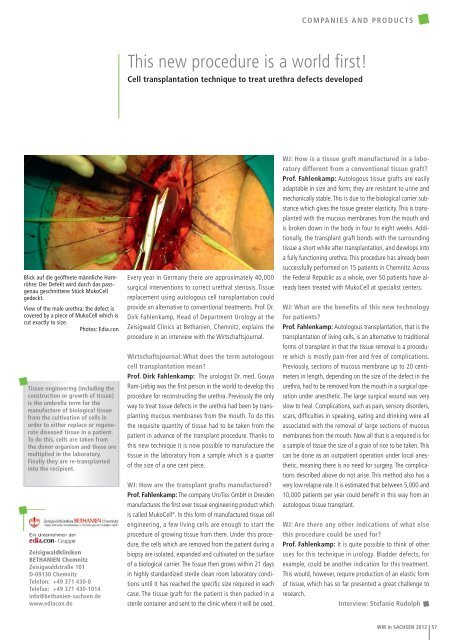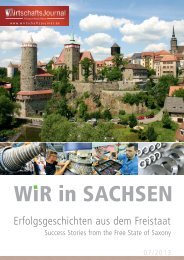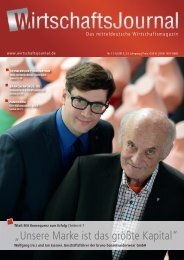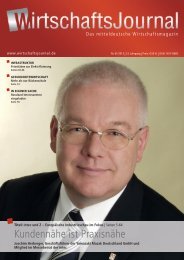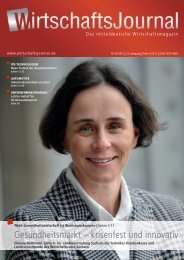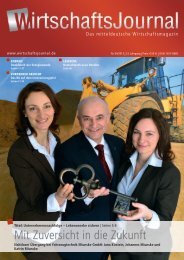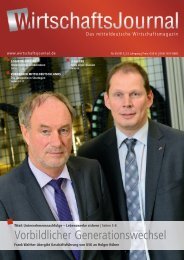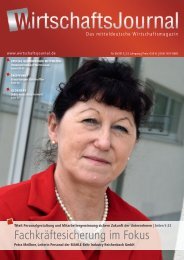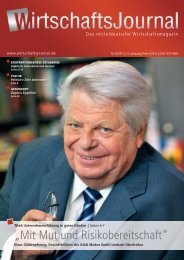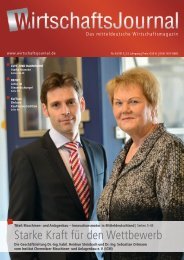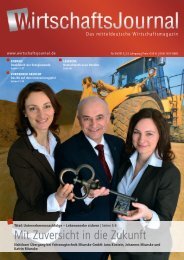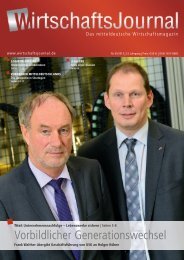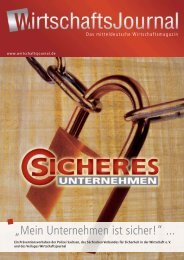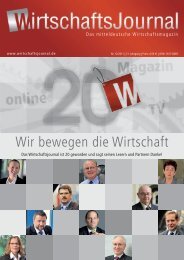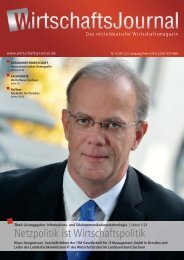Wir in Sachsen 2012 - Wirtschaftsjournal
Wir in Sachsen 2012 - Wirtschaftsjournal
Wir in Sachsen 2012 - Wirtschaftsjournal
Erfolgreiche ePaper selbst erstellen
Machen Sie aus Ihren PDF Publikationen ein blätterbares Flipbook mit unserer einzigartigen Google optimierten e-Paper Software.
Blick auf die geöffnete männliche Harnröhre:<br />
Der Defekt wird durch das passgenau<br />
geschnittene Stück MukoCell<br />
gedeckt.<br />
View of the male urethra: the defect is<br />
covered by a piece of MukoCell which is<br />
cut exactly to size.<br />
Photos: Edia.con<br />
Tissue eng<strong>in</strong>eer<strong>in</strong>g (<strong>in</strong>clud<strong>in</strong>g the<br />
construction or growth of tissue)<br />
is the umbrella term for the<br />
manufacture of biological tissue<br />
from the cultivation of cells <strong>in</strong><br />
order to either replace or regenerate<br />
diseased tissue <strong>in</strong> a patient.<br />
To do this, cells are taken from<br />
the donor organism and these are<br />
multiplied <strong>in</strong> the laboratory.<br />
F<strong>in</strong>ally they are re-transplanted<br />
<strong>in</strong>to the recipient.<br />
Zeisigwaldkl<strong>in</strong>iken<br />
BETHANIEN Chemnitz<br />
Zeisigwaldstraße 101<br />
D-09130 Chemnitz<br />
Telefon: +49 371 430-0<br />
Telefax: +49 371 430-1014<br />
<strong>in</strong>fo@bethanien-sachsen.de<br />
www.ediacon.de<br />
C O M PA N I E S A N D P R O D U C T S<br />
This new procedure is a world first!<br />
Cell transplantation technique to treat urethra defects developed<br />
Every year <strong>in</strong> Germany there are approximately 40,000<br />
surgical <strong>in</strong>terventions to correct urethral stenosis. Tissue<br />
replacement us<strong>in</strong>g autologous cell transplantation could<br />
provide an alternative to conventional treatments. Prof. Dr.<br />
Dirk Fahlenkamp, Head of Department Urology at the<br />
Zeisigwald Cl<strong>in</strong>ics at Bethanien, Chemnitz, expla<strong>in</strong>s the<br />
procedure <strong>in</strong> an <strong>in</strong>terview with the <strong>Wir</strong>tschaftsjournal.<br />
<strong>Wir</strong>tschaftsjournal: What does the term autologous<br />
cell transplantation mean?<br />
Prof. Dirk Fahlenkamp: The urologist Dr. med. Gouya<br />
Ram-Liebig was the first person <strong>in</strong> the world to develop this<br />
procedure for reconstruct<strong>in</strong>g the urethra. Previously the only<br />
way to treat tissue defects <strong>in</strong> the urethra had been by transplant<strong>in</strong>g<br />
mucous membranes from the mouth. To do this<br />
the requisite quantity of tissue had to be taken from the<br />
patient <strong>in</strong> advance of the transplant procedure. Thanks to<br />
this new technique it is now possible to manufacture the<br />
tissue <strong>in</strong> the laboratory from a sample which is a quarter<br />
of the size of a one cent piece.<br />
WJ: How are the transplant grafts manufactured?<br />
Prof. Fahlenkamp: The company UroTiss GmbH <strong>in</strong> Dresden<br />
manufactures the first ever tissue eng<strong>in</strong>eer<strong>in</strong>g product which<br />
is called MukoCell ® . In this form of manufactured tissue cell<br />
eng<strong>in</strong>eer<strong>in</strong>g, a few liv<strong>in</strong>g cells are enough to start the<br />
procedure of grow<strong>in</strong>g tissue from them. Under this procedure,<br />
the cells which are removed from the patient dur<strong>in</strong>g a<br />
biopsy are isolated, expanded and cultivated on the surface<br />
of a biological carrier. The tissue then grows with<strong>in</strong> 21 days<br />
<strong>in</strong> highly standardized sterile clean room laboratory conditions<br />
until it has reached the specific size required <strong>in</strong> each<br />
case. The tissue graft for the patient is then packed <strong>in</strong> a<br />
sterile conta<strong>in</strong>er and sent to the cl<strong>in</strong>ic where it will be used.<br />
WJ: How is a tissue graft manufactured <strong>in</strong> a laboratory<br />
different from a conventional tissue graft?<br />
Prof. Fahlenkamp: Autologous tissue grafts are easily<br />
adaptable <strong>in</strong> size and form; they are resistant to ur<strong>in</strong>e and<br />
mechanically stable. This is due to the biological carrier substance<br />
which gives the tissue greater elasticity. This is transplanted<br />
with the mucous membranes from the mouth and<br />
is broken down <strong>in</strong> the body <strong>in</strong> four to eight weeks. Additionally,<br />
the transplant graft bonds with the surround<strong>in</strong>g<br />
tissue a short while after transplantation, and develops <strong>in</strong>to<br />
a fully function<strong>in</strong>g urethra. This procedure has already been<br />
successfully performed on 15 patients <strong>in</strong> Chemnitz. Across<br />
the Federal Republic as a whole, over 50 patients have al -<br />
ready been treated with MukoCell at specialist centers.<br />
WJ: What are the benefits of this new technology<br />
for patients?<br />
Prof. Fahlenkamp: Autologous transplantation, that is the<br />
transplantation of liv<strong>in</strong>g cells, is an alternative to traditional<br />
forms of transplant <strong>in</strong> that the tissue removal is a procedure<br />
which is mostly pa<strong>in</strong>-free and free of complications.<br />
Previously, sections of mucous membrane up to 20 centimeters<br />
<strong>in</strong> length, depend<strong>in</strong>g on the size of the defect <strong>in</strong> the<br />
urethra, had to be removed from the mouth <strong>in</strong> a surgical operation<br />
under anesthetic. The large surgical wound was very<br />
slow to heal. Complications, such as pa<strong>in</strong>, sensory disorders,<br />
scars, difficulties <strong>in</strong> speak<strong>in</strong>g, eat<strong>in</strong>g and dr<strong>in</strong>k<strong>in</strong>g were all<br />
associated with the removal of large sections of mucous<br />
membranes from the mouth. Now all that is a required is for<br />
a sample of tissue the size of a gra<strong>in</strong> of rice to be taken. This<br />
can be done as an outpatient operation under local anesthetic,<br />
mean<strong>in</strong>g there is no need for surgery. The complications<br />
described above do not arise. This method also has a<br />
very low relapse rate. It is estimated that between 5,000 and<br />
10,000 patients per year could benefit <strong>in</strong> this way from an<br />
autologous tissue transplant.<br />
WJ: Are there any other <strong>in</strong>dications of what else<br />
this procedure could be used for?<br />
Prof. Fahlenkamp: It is quite possible to th<strong>in</strong>k of other<br />
uses for this technique <strong>in</strong> urology. Bladder defects, for<br />
example, could be another <strong>in</strong>dication for this treatment.<br />
This would, however, require production of an elastic form<br />
of tissue, which has so far presented a great challenge to<br />
research.<br />
Interview: Stefanie Rudolph<br />
WIR <strong>in</strong> SACHSEN <strong>2012</strong> 57


